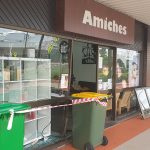
December 13, 2016
by Ian Crosthwaite
Kingaroy Landcare Group members, interested landholders and Natural Resource Management workers recently took a free bus trip sponsored by the Burnett Mary Regional Group (BMRG) to examine local NRM projects.
The six different projects provided a fact finding and information sharing opportunity about different approaches to weed control and revegetation in different parts of the South Burnett.
The tour began with a visit to Meandu Mine to assess revegetation works carried out on previously mined areas.
Paul Veivers, an environmental specialist who works for Stanwell Corporation, pointed out a number of rehabilitated sites at the mine, and discussed the merits of seeding programs for disturbed areas.
Most visitors were impressed with the extent of the revegetation works and how successful they seem to have been in reducing runoff and providing habitat for wildlife.
Paul said there was still a long way to go but initial results seem encouraging, with locally sourced seed being used to create plant communities similar to those prior to mining.
Close to Meandu Mine, members of the Neumgna Landcare Group have been undertaking a major lantana control effort.
Glenn Douglass was able to show excellent results using a combination of mechanical removal, prescribed and targeted herbicide regimes, and follow-up.
Glenn’s methods are returning formerly lantana covered country to stable and profitable good quality grazing land.
The 20 or so participants then headed to Middle Creek to inspect a severe infestation of cats claw creeper.
Cats claw creeper is a very aggressive vine that grows over vegetation, including tall trees, and smothers it.
Kay Enklemann, BMRG’s Regional Landcare Facilitator, had 2000 jewel beetles to release and hopefully establish a thriving colony that will make a biological impact on the cats-claw creeper.
The 2000 beetles cost $920, and this was funded with a BMRG grant.
From this site the group moved on to examine Chinese Celtis control efforts along Barkers Creek.
Chinese Celtis can develop into large trees and dense thickets, and during the 2011 and 2013 floods the plant impeded flood water flows, which led to extensive erosion and crop damage along the creek’s banks.
In a joint project between Kingaroy Landcare Group, local landholders, Stanwell Corporation, BMRG and the Federal Government, Chinese Celtis was removed from several kilometres of creek banks.
The next stop was a farm forestry project that is still underway in the South Burnett, and how this might benefit landholders.
Damien O’Sullivan, from the Department of Agriculture and Fisheries, explained that successful farm forestry projects appear to be dependent on the species of tree chosen.
And ideally, they should be high value timber species rather than just trees grown for woodchips.
The final stop was the roadside verge adjacent to Alwyn Kamholtz’s farm on Weeks Road, where the South Burnett Regional Council’s Biodiversity Project has planted 150 rainforest trees.
Over 12 species have taken off in the last year or so, showing that correct soil preparation and initial watering and maintenance can provide the start of a useful re-vegetation project.
Alwyn explained that he had only watered the new trees twice and now the plants were at a point where they should be able to survive on their own.
Weeks Road is just a small part of the Council’s overall project, which has seen more than 20,000 trees planted throughout the region. These can be seen with their distinctive red tree guards.
Overall, the day provided a fantastic opportunity to examine different methods of weed control and re-vegetation projects that are working in the area.
All participants agreed the exercise provided them with land management information that will stand them in good stead for any future projects they want to undertake.
























